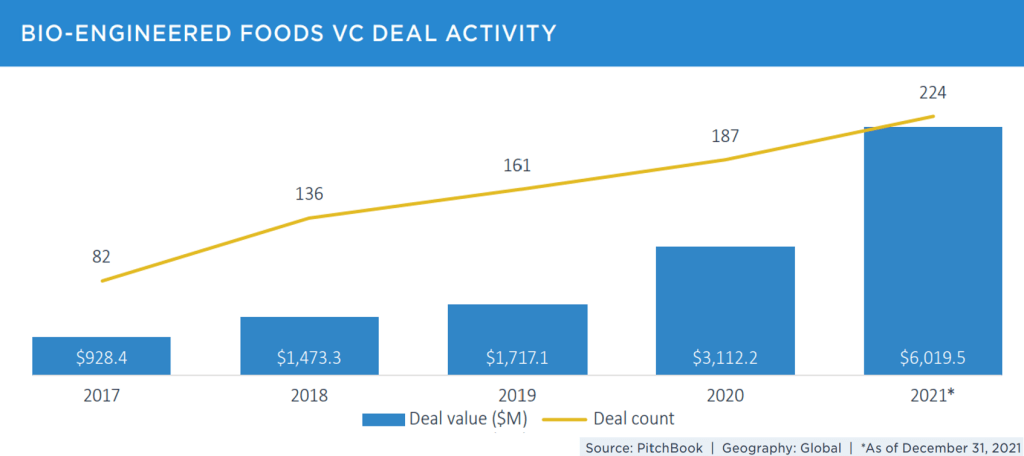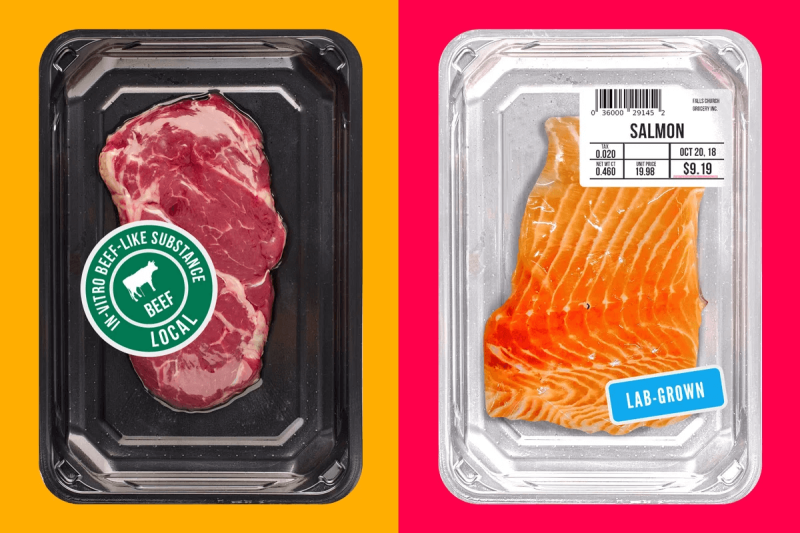Which would you choose?
Most consumers don’t yet realize that there are three different types of alternative proteins that achieve the desired amino acid profile.

Plant-based proteins
Most people are familiar with plant-based burgers such as Impossible Foods and Beyond Meat. Impossible is sold everywhere from Target to Starbucks to Walmart to your local grocery store. The perception is that it is healthier than regular meat because it is made from plants. In truth, it depends on the burger, how it was made, the nutritional profile introduced, and the number of ingredients.
Despite all the marketing, the consumer places alternative burgers slightly behind your traditional black bean and veggie burger which may be why Morningstar Farms has the largest unit sales in the frozen section. Chicken alternatives like Daring and Abbot’s Butcher come in third. Interestingly enough, of those surveyed, 66% of consumers prefer to get their alternative meat when they buy their groceries.
Cultivated proteins
Egg whites without chickens, fish without the fins, and meat without the animal are all examples of cultivated protein. Instead of being raised on a farm or in the sea, scientists take cells directly from an animal, or bird, or fish, and grow the cells in a lab bioreactor. It is a complicated and safe technology that puts together the animal cells, mixes it with the right speed, and then adds in aeration and various nutrients. These added nutrients are expensive and there are many: glucose, 20 essential and non-essential amino acids, fatty acids, phosphate, trace minerals, and various vitamins, hormones, and other growth factors.
Some of the benefits touted for these proteins are that there are no pesticides, antibiotics, or any ingredients associated with feeding animals. The knowledge and technology are prolific at various companies and university labs all around the world. Although it could take quite a few years to scale up enough cells to feed 10 billion people eight ounces of protein each day for the same cost as animal-based meat.
Despite its challenges, Singapore’s FDA equivalent was the first regulatory agency to approve cultured meat grown by Esco Aster in partnership with Eat Just.
Fermented proteins
In this case, it is milk without the cow, or fermenting mushrooms to make dairy, meat, protein powder, and food ingredients, or turning sugars from grain into burgers, chicken, noodles, and snacks. Fermented protein technology is difficult, but the concept is as old as the the creation of beer, wine, sauerkraut, and yogurt.
In ancient times, fermentation used microbes in food, and still uses that same method today. And to make protein alternatives it ferments a variety of live microorganisms to make anything that can be made from an animal, plant, bird, or fish.
What does the future hold?
Each year the technology gets stranger and more real. According to Pitchbook, since 2010, alternative protein start-ups have raised $11 billion, with $8 billion of that raised in just the past two years.

By 2035, Boston Consulting, and other firms, predict that there will be $290 billion invested. That is more, as of this writing, of the market cap of two large protein companies: Tyson and JBS combined. However, these proteins make up less than 1% of the total protein we consume. According to Statista Consumer Market Outlook, the average U.S. per capita consumption was about 0.6 pounds a year, projected to go to 1.7 pounds a year by 2035.
Governments and NGOs are embracing it with investments. The Good Food Institute, a nonprofit is ‘reimagining meat production which is building a world where alternative proteins are the default choice.” In addition, the USDA gave $10 million to Tufts University to develop cultivated meat. The USDA has also given $2.7 million for five alternative protein projects. The National Science Foundation gave $3.5 million to UCLA for their cultivated meat program. The Netherlands announced $65 million for cultivated meat and precision fermentation. Given that Mark Post, one of the originators of cell-based meat is in the Netherlands, this is no surprise.
Another hairy audacious goal
Getting rid of animals entirely? It is one thing to have the technology, it is another thing to change consumer behavior. It will be challenging to ask billions of people to fundamentally change their dietary patterns and habits that consumers know and enjoy. Will alternative protein burgers and steaks still sizzle on the grill for the summer barbeques?
Alternative meat companies – and the financial supporters – are enthusiastically promoting new meat technologies. Patrick Brown of Impossible Foods has said that their mission is to replace the use of animals as food by 2035. ReThink, a think tank, also predicts the demise of the farm animal. Their premise is that by 2030, precision fermentation and production called ‘food as software’ will supersede the animal production system of today.
Max Rye, co-founder of cell-based protein company TurtleTree, told McKinsey that cell based meat can save 78 to 96 percent of GHG compared to traditional agriculture.
Andre Menezes, co-founder of Singapore-based, Next Gen Foods, added: “we don’t have time to wait; we are in a late-stage extinction crisis.”
So what does the consumer say?
We turned to Mintel, a consumer research company for the answer. In Europe, the U.K. and the U.S., many have incorporated plant-based meat into their diet but they still eat animal and bird based protein. For those who choose alternative proteins, they eat according to their values.
“The next five years is a pivotal time for the category. In the shifting socioeconomic environment, the challenge is to meet consumers’ multifaceted value expectations.”
– Dasha Shor, Global Food Analyst at Mintel
The environmental and personal health concerns bring consumers closer to the lab. According to YouGov surveys, 48% of consumers eat meatless meat about once a month and do so because they think it is healthier for them and better for the environment.
According to Mintel, consumers are worried about sustainability and 70% of US consumers agree that food/drink companies/brands can be leaders in protecting the environment.
In addition, Mintel continues to stress that consumers need to feel that they get value for their protein. As inflation rises, alternative protein has to beat animal protein on the price. For instance, Alpha Foods is promoting their plant based Chik’n Nuggets as less expensive than regular chicken to draw people to their category.
But having said all that, 52% of Americans have never tried it.

How does this scale?
This won’t be a simple light switch change as technologies, infrastructure, and supplies must match current production. To create proteins from air, or chickens that don’t live in a hen house, or meat made in a fermentation tank will take years to scale.
Mintel analysts went on to stress the importance of innovation: “meat alternatives will be challenged to deliver not only on health, taste, and price but also attract consumers with hyper-convenient offerings beyond burgers and sausages.” Fermentation technology, and eventually cellular agriculture, will be important solutions to addressing meat alternatives’ taste and texture challenges and meeting the protein needs of the growing global population.
The size of the global protein business is massive. In 2018, the world ate 69 billion chickens and turkeys, and 304 million cattle and pigs. As consumers around the world increase their income they naturally eat more protein. In 2020, that was about 467 million metric tons of animal protein. That would be about 93 pounds per human on earth. In the United States, we have held steady for the past three years eating about 225 pounds of protein per person, per year. That is a lot of protein!

What does the future hold? Both!
Today’s consumers, regardless of their age, are not ‘either/or’ on their protein. Consumers are still excited to eat animal protein as well as look forward to including plant or alternative proteins in their diets. Initial innovation and acceptance will mostly be in Asia-Pacific. This is no surprise due to their high population growth and need for food security.

Will the animals that feed us today become obsolete in eight to 13 years? Probably not. But will technology keep improving and the ability to scale become easier? It is in the human DNA to keep improving and striving forward. We have come a long way from cooking brontosaurus burgers over the fire.
The bottom line
For the new wave of alternative protein brands to be successful, they must taste great, have increased health benefits, meet consumer transparency requirements, and be affordable. In addition, the animal-based meat producers will continue to innovate on the environmental, health, and animal welfare concerns. Everyone needs to eat protein and it is the combination of traditional animals, fermentation tanks, bioreactors, and plant-based formulas that will sustainably help feed all people in all cultures and countries around the world.
Lucy M. Stitzer is a food writer and regular contributor at Dirt to Dinner. She served on the Board at the food company Cargill for many years.
A version of this article was originally posted at Dirt To Dinner and is reposted here with permission. Dirt To Dinner can be found on Twitter @Dirt_To_Dinner































